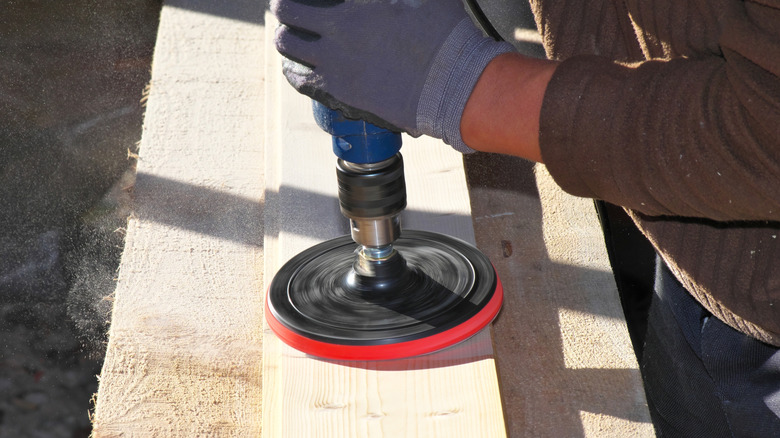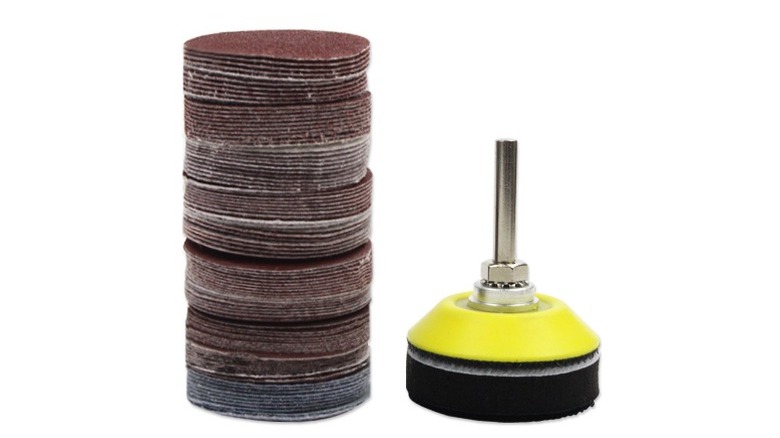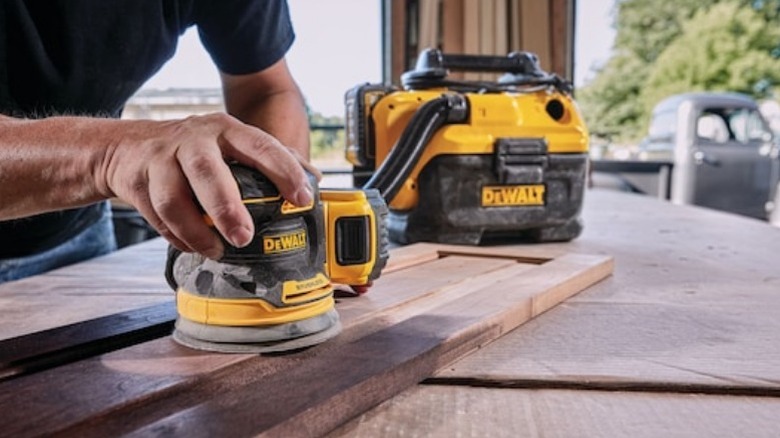Can You Use A Drill As A Sander? Here's What You'll Need
We may receive a commission on purchases made from links.
Having the right tool for the job can make work smoother, easier, and more efficient. That said, going out and buying a brand-new power tool isn't always a practical solution for every situation. There are a lot of people out there who aren't professional craftsmen and might only need to use a tool once or twice. Power tools can be expensive, and so there are a lot of situations where you might be looking to see if there's a way to get by with what you already have in your garage in order to save a bit of cash.
One of the most useful and versatile items you can have in your collection is a basic power drill. These are available from a wide range of power tool brands, and they aren't limited to simply drilling holes and driving fasteners. The adjustable chuck found in most modern drills makes them compatible with a wide variety of drill extensions that have nothing to do with drilling. This vastly expands the tool's utility and allows you to use it for a wide variety of applications that you might not have considered. Those who need to do a bit of sanding, but don't want to purchase a dedicated sander, might be wondering if they can spare themselves some elbow grease and use their drill as a power sander. The good news is that you absolutely can, but there are a few caveats. There are a couple of things that you'll still need to buy, and there are also a few compelling reasons why a dedicated random orbital sander might be a better option if you can afford it.
All you need is an attachment and some sandpaper
Those who wish to turn their drill into a power sander can easily do so with two items: a hook-and-loop sanding disk attachment and some sandpaper. The attachment is a simple piece of equipment. One end of it is a metal shank that goes into the drill's chuck, while the other is a round disk that has a Velcro-like plastic hook material on its surface. This material allows users to easily attach the loop-backed sandpaper pads that they want to use. Allowing them to be removable in this way serves two functions: The first is that it allows you to easily remove and dispose of pads that have been worn down from use, and the second is that you can easily change between sandpaper pads with different grit ratings. Lower-grit pads are coarser and will quickly remove more material, while higher-grit pads are finer and will produce a smoother finish.
Both the attachment and the sandpaper pads are very affordable and can often be found bundled together to be sold as kits. The Coceca 2-inch Drill Sander Attachment sold on Amazon, for instance, only costs $11.99 and includes 100 sanding disc pads in a wide range of different grits. This should be all you need to get started.
Drawbacks to using a drill over a random orbital sander
So, now you know that there is a cheap and easy way to make your drill into a power sander, but there are a few reasons why it might not be the best solution when compared to something like a random orbital sander.
The first is ergonomics. Sanding is often a long and arduous activity that requires the constant application of mild, downward pressure. Random orbital sanders are often called 'palm sanders' because of the way they're designed for you to hold them. They make it easy for you to gently move them across a surface while applying slight, even pressure. Drills aren't ergonomically designed for this kind of application. Prolonged use in this manner can be fatiguing on the arm, shoulder, and wrist.
Another drawback has to do with the type of rotation the drill is designed for. RO sanders are generally better than regular orbital sanders due to the 'random' way they move. They rotate in elliptical cycles while simultaneously moving back and forth. This non-uniform pattern is specifically designed to sand without leaving rings or marks on the material that you might see from other forms of rotation. A drill simply rotates in even circles, and will therefore produce a less even finish on whatever you're sanding.
Dust collection presents yet another reason why it might be better to get a dedicated sander. Sanding is a messy process. Most modern random orbital sanders include several holes in the sandpaper and the underlying pad that can be used to draw the dust from the material being sanded. This is usually either captured in an attached dust bag or through a port that can be connected to a separate shop vacuum. Drills don't have this.


